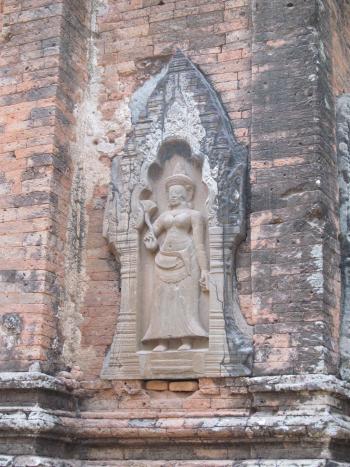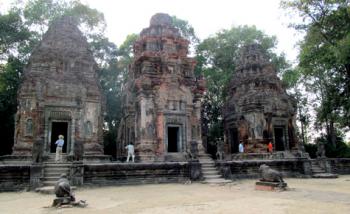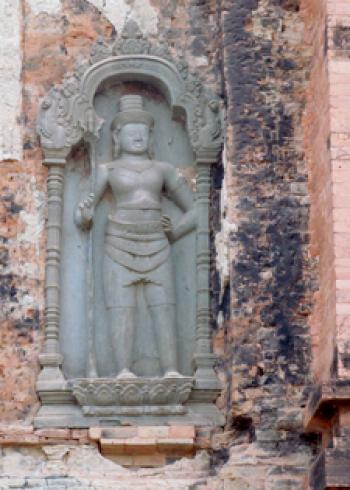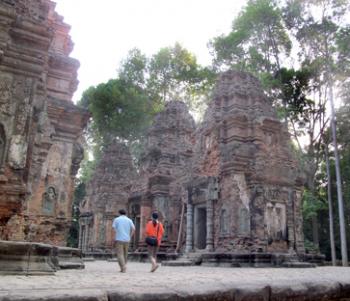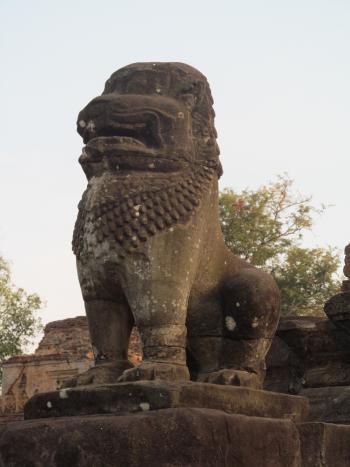Early Khmer temples at Angkor
This item appears on page 54 of the October 2016 issue.
Early Khmer temples at Angkor
Tomes have been written about Angkor. Not at all surprising, since this area, located in northwestern Cambodia, is one of the world’s foremost archaeological sites! It was, in its time, one of the greatest empires on Earth.
From the early ninth century until roughly the mid-15th, this part of Cambodia witnessed an explosion of temple building that reached its apogee in the 12th century with the construction of Angkor Wat by the Khmer king Suryavarman II, and Angkor Thom by Jayavarman VII. Both archaeological sites are “must sees” for visitors to Angkor, as are, arguably, Bayon, Ta Prohm, Baphuon and Banteay Srei. Ask 10 people for a list of their favorite half-dozen sites and you’ll be sure to get 10 different answers.
My husband, Paul, and I had not been to Angkor in over 20 years. We wanted to revisit the best-known temple complexes during our 4-day trip in February 2016, but we also wanted to do something a bit different. We wanted to see where all this building frenzy had begun in the ninth century.
This meant traveling a short 10 miles southeast of Siem Reap, the city closest to the Angkor temples, to a group of temples labeled the Roluos Group. There, in close proximity to each other, are the temple complexes of Preah Ko, Bakong and Lolei, built by two Khmer kings at the tail end of the ninth century.
Ancestor temple
Preah Ko was the first of the Roluos temple complexes we visited. It was one of the earliest-built temples in the Angkor area, constructed in AD 879 by Indravarman I (reigned AD 877-889) to honor his maternal and paternal ancestors. This temple, as well as the other two we were to visit, were part of Hariharalaya, the Khmer capital built early in the ninth century.
Preah Ko is an open site now, with a low brick platform on which six brick towers are arranged in two rows. Eleven hundred years ago, this is not the way visitors to the temples would have seen the towers. Before reaching them, visitors would have passed through a series of outer walls and moats, now gone.
The name Preah Ko means “Sacred Bull,” so it is fitting that three statues of Nandi, the bull, associated with the Hindu god Shiva, stand in front of the temple platform. Three sets of steps guarded by lions lead up to the temples on the platform.
The three temples in the front row were dedicated to Indravarman I’s male ancestors and are protected by stone male guardians called dvarapalas, while those in the row behind, protected by female guardians, devatas, are dedicated to female ancestors.
The lintels over the doorways display intricate carvings with abundant detail. One (on the left tower in the front row) shows curlicue foliage “evolving” into naga (serpent) heads.
Royal temple
Bakong Temple is one of the earliest pyramid temples built by a Khmer king. Dedicated in AD 881 by Indravarman I, Bakong’s five receding terraces topped by a central sandstone tower were meant to symbolize Mount Meru, the center of the Hindu universe.
There are a multitude of sanctuaries and shrines, eight surrounding the base of the pyramid and 12 around the central tower. There are also a multitude of stone animals. Lions guard the staircases. Elephants adorn the corners of the pyramid. Seven-headed nagas line one of the causeways leading to the temple complex.
Like Preah Ko, Bakong was once enclosed by concentric walls and moats, with causeways crossing the moats. Gopuras, or gateway towers, stood at the base of the temple steps on each of the four pyramid sides, adding to the impression of majesty as one approached.
As with Preah Ko, it is worthwhile to spend time examining the intricately carved lintels, particularly those on the sanctuaries on the west side and in the southwest corner at the base of the pyramid. Warriors ride on elephants. Makaras, mythical sea creatures, and writhing nagas proliferate. Gods sit atop kalas, demon-like creatures that symbolize time.
Lolei in ruins
Of the three temple complexes in the Roluos Group, Lolei is the one in the most ruinous state. Built in AD 893 by Indravarman I’s son and successor, Yasovarman I (reigned 889-910), he was the last of the Khmer kings to make Hariharalaya his capital. Like Preah Ko, this temple was dedicated to the king’s ancestors.
Originally, six temples may have been planned, with three brick towers in front honoring male ancestors and the back three, female ancestors. In any case, only four were constructed, perhaps because Yas´ovarman I decided to establish a new capital and, so, abandoned building at Lolei.
Much has disappeared. The island on which the temples once stood is now a terrace, with the surrounding baray, or reservoir, gone. The enclosing brick wall has all but disappeared along with the gopuras, or gateways. Two of the four towers are partially collapsed.
But enough intricate carving remains, as well as beautiful dvarapalas, male guardian statues, and devatas, female guardian statues, to make Lolei a “must see” if visiting the Roluos Group.
All three temple complexes were built within a period of just 14 years. They preceded the greatest of the Angkor constructions by more than 200 years, and, yet, it is easy to see how the later temples evolved and developed from these early ones.
If you go…
The Roluos Group is about a half-hour drive from Siem Reap. The three temple complexes are located close to each other and can be easily visited within two to three hours.
One wonderful advantage in visiting the Roluos temples is the good possibility of having them almost all to yourself, in contrast to joining the throngs you’ll find at the other Angkor temples. We were the only ones at Lolei and Preah Ko, and we shared Bakong with perhaps a dozen others.
We hired a car and driver to take us to the Roluos temple complexes. We emailed San Park (sanpark.angkor@gmail.com) in advance of our trip, using him for each of the six half-day excursions during our four days at Angkor. The cost was $240, total, for all six excursions, which also included airport transfers.
Similar arrangements can be made through the hotel you’re staying in or through a local travel agent or by booking online in advance, as we did.
Foreign visitors must buy a one-day, 3-day or 7-day pass (until Feb. 1, 2017, $20, $40 or $60, respectively) to visit temples within the Archaeological Park where many of the Angkor temples are located. The Roluos Group can also be visited with this pass.
On trips to Singapore, we love staying at Raffles. On this trip to Angkor, in Siem Reap it was love at first sight at the Raffles Grand Hotel d’Angkor (1 Vithei Charles de Gaulle, Khum Svay Dang Kum, Siem Reap, Cambodia; phone 855 63 963 888 or, in the US/Canada, 800/768-9009, email rga.concierge@raffles.com or visit www.raffles.com/siem-reap).
Our colonial-era Landmark Room, with a balcony overlooking the immense pool, was understatedly elegant. Dining was always special — breakfast buffets in the Café d’Angkor, cocktails in the atmospheric Elephant Bar or beside the pool, elegant dining in Restaurant Le Grand or casual dining in The Conservatory, which also served a traditional afternoon tea.
One evening, at the hotel’s Apsara Terrace Restaurant, we combined a Cambodian music-and-dance show with one of the best dinner buffets we’ve ever had.
Sometimes it’s the little things that say a lot about the quality of a hotel, like the cool towels handed out to us as we entered the hotel lobby after a hot morning or afternoon of temple prowling. Or the smile of the elevator attendant as he opened the wrought-iron gate of the old-fashioned lift for us 10 times a day.
Room rates started at $445, not including service charges and taxes.


